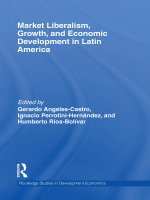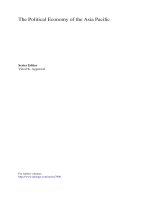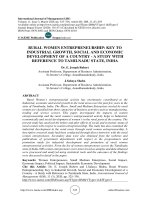Economic growth and economic development 375
Bạn đang xem bản rút gọn của tài liệu. Xem và tải ngay bản đầy đủ của tài liệu tại đây (63.29 KB, 1 trang )
Introduction to Modern Economic Growth
7.9. References and Literature
The main material covered in this chapter is the topic of many excellent applied
mathematics and engineering books. The purpose here has been to provide a review
of the results that are most relevant for economists, together with simplified versions
of the most important proofs. The first part of the chapter is closer to the calculus
of variations theory, because it makes use of variational arguments combined with
continuity properties. Nevertheless, most economists do not need to study the calculus of variations in detail, both because it has been superseded by optimal control
theory and also because most of the natural applications of the calculus of variations
are in physics and other natural sciences. The interested reader can look at Gelfand
and Fomin (2000). Chiang (1992) provides a readable and simple introduction to
the calculus of variations with economic examples.
The theory of optimal control was originally developed by Pontryagin et al.
(1962). For this reason, the main necessary condition is also referred to as the
Pontryagin’s (Maximum) Principle. The type of problem considered here (and in
economics more generally) is referred to as the Lagrange problem in optimal control
theory. The Maximum Principle is generally stated either for the somewhat simpler
Meyer problem or the more general Bolza problem, though all of these problems are
essentially equivalent, and when the problem is formulated in vector form, one can
easily go back and forth between these different problems by simple transformations.
There are several books with varying levels of difficulty dealing with optimal
control. Many of these books are not easy to read, but are also not entirely rigorous
in their proofs. An excellent source that provides an advanced and complete treatment is Fleming and Rishel (1975). The first part of this book provides a complete
(but rather different) proof of Pontryagin’s Maximum Principle and various applications. It also provides a number of theorems on existence and continuity of optimal
controls. A deeper understanding of sufficient conditions for existence of solution
and the structure of necessary conditions can be gained from the excellent (but
abstract and difficult) book by Luenberger (1969). The results in this book are general enough to cover both discrete time and continuous time dynamic optimization.
This book also gives a very good sense of why maximization in function spaces is
361









